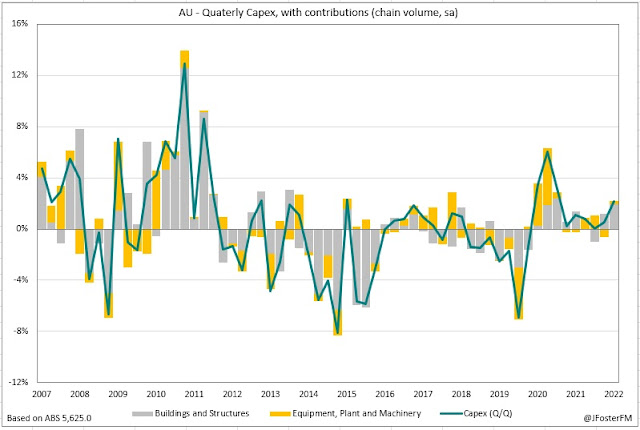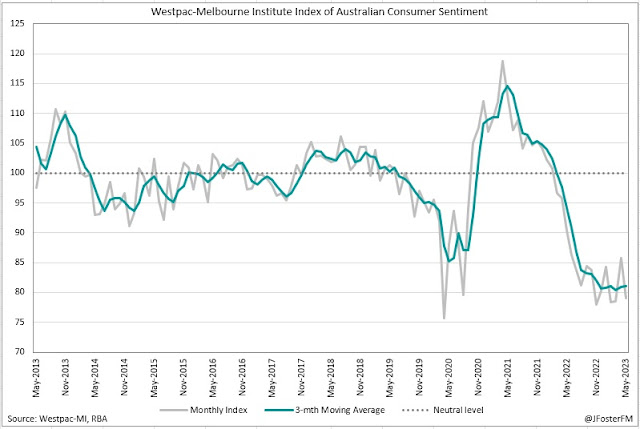Australian private sector capital expenditure increased by more than expected in the March quarter, extending its upswing since the middle of 2022. Equipment investment advanced at its fastest quarterly pace since 2021. Resilience in firms' forward-looking investment plans to a slower growth outlook remains intact.
CapEx — Q1 | By the numbers
- Private sector capex expanded by 2.4% in the March quarter, an upside result on the market estimate (1%), to be up 6.3% through the year. December quarter capex was revised to a 3% rise from 2.2% previously.
- Equipment, plant and machinery capex increased by 3.7% quarter-on-quarter, accelerating from a 0.6% gain in Q4, to be 5.8% higher in year-ended terms.
- Buildings and structures capex advanced by 1.3%, with growth through the year up at 6.8% from 4.9% previously.
- Firms' 6th estimate of capex plans for 2022/23 came in at $162.6bn, up 2.7% on estimate 5 from 3 months ago. Capex is on track for a year-to-year rise of 13.5%.
- Year-ahead investment plans for 2023/24 were posted at $137.6bn, 6.4% higher than the 1st estimate and 5% up on estimate 2 for 2022/23.
CapEx — Q1 | The details
Capex by Australian firms has regained momentum after being subdued for much of last year. A 3% rise into year-end has been followed by a solid 2.4% increase in the March quarter (in real or inflation-adjusted terms). Equipment investment was up by 3.7% in Q1, its strongest quarterly rise in two years. Buildings and structures spending slowed to a 1.3% rise coming off a large increase (5.3%) in Q4.
Non-mining investment (2.7%) rose at a similar pace to the previous two quarters, up overall by 8.4% since the middle of 2022. Equipment investment accelerated in Q1 (3.4%) as growth in the buildings and structures component moderated (2%).
Over in the mining sector, capex rose modestly in the first quarter (1.7%), driven by investment in equipment (5.2%). Total capex in the sector remains little changed since 2017, following the unwind from the mining investment boom in the early part of the decade.
Firms' investment plans in the current financial year were upgraded by 2.7% to a projected spend of $162.6bn (in nominal terms). This figure for estimate 6 was stronger than implied by the average historical upgrade from estimate 5 (around 1%), likely accounted for by high inflation. The latest estimate suggests that capex is on track to rise by 13.5% compared to 2021/22.
Year-ahead investment plans were revised to $137.6bn in firms' 2nd estimate for 2023/24, up from $129.4bn on estimate 1, representing an upgrade of 6.4%. This is a softer upgrade than seen between estimates 1 and 2 in 2021/22 (7.8%) and 2022/23 (12.3%) and was also below my forecast for a figure above $140bn. But, overall, capex plans appear to remain resilient and are at their highest level since 2014/15, though inflationary effects are playing a role. Non-mining investment plans were raised by 8.1% on estimate 1 to $94.8bn and plans in the mining sector lifted by 2.7% to $42.8bn.
CapEx — Q1 | Insights
A stronger-than-expected result for quarterly capex, driven by the equipment component. This suggests business investment supported economic growth through the first quarter of 2023. Forward-looking investment plans for 2023/24 may have come in a bit softer than anticipated, but there does not appear to have been a material reassessment by firms despite weak confidence and outlook for slower growth in Australia and offshore.




















































